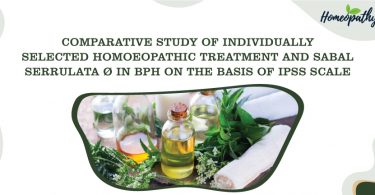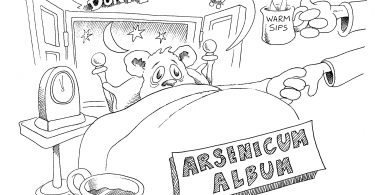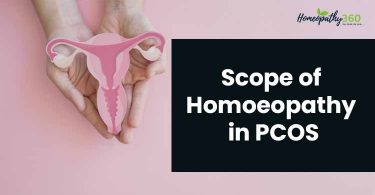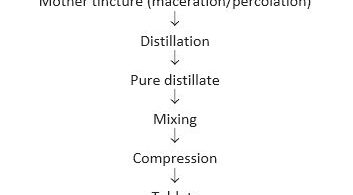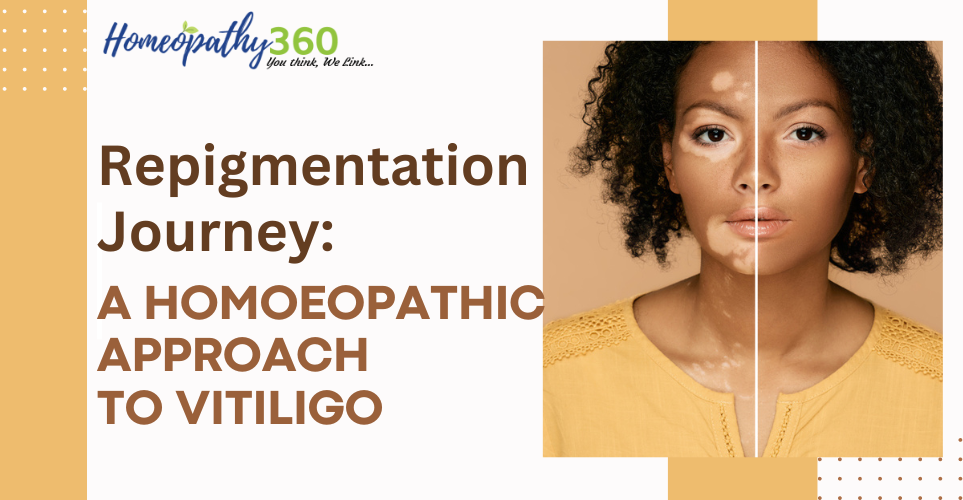
Abstract
Vitiligo, a chronic skin disorder characterized by depigmented patches, affects individuals globally, with prevalence ranging from 0.5% to 2% worldwide (World Health Organization). Traditional treatments often focus on symptom management. However, this paper explores the efficacy of homeopathy in treating vitiligo. Through individualized remedies homeopathy targets the root cause of the disease, aiming for repigmentation and overall well-being. The paper showcases a case study illustrating the transformation from conventional treatment to homeopathic intervention. By addressing both physical and emotional symptoms, homeopathy offers a holistic approach to vitiligo management.
Keywords:
Vitiligo, homeopathy, holistic approach
Introduction
Vitiligo is a skin condition characterized by the loss of pigment in patches of skin, resulting in white or light-colored spots. While the exact cause is unknown, it is believed to involve a combination of genetic, autoimmune, and environmental factors. Common signs and symptoms include depigmented patches on the skin, which may appear anywhere on the body, particularly areas exposed to the sun. Complications may arise from social stigma, psychological distress, and increased risk of sunburn and skin cancer. Homeopathy offers a holistic approach to managing vitiligo, aiming to address the underlying causes and stimulate the body’s natural healing processes. These remedies aim to balance the body’s immune system, promote melanocyte production, and encourage repigmentation of the skin. While homeopathy cannot cure vitiligo, it can help alleviate symptoms, slow down disease progression, and improve overall quality of life for affected individuals.
Case Profile
A 9-year-old female student presented with hypopigmented patches appearing on her lips, fingertips, palms, and soles. These patches first appeared when she was 3 years old, starting initially on her fingertips before gradually spreading to other areas. Although the spread has slowed down, the patches remain stable and are not increasing presently. Notably, there is no accompanying itching, pain, or burning sensation associated with these patches. Past treatments include both ayurvedic remedies and allopathic treatments. Additionally, the patient complains of occasional headaches, particularly on the left temples, which worsen with the stress of studies or digestive upset, such as after consuming outside food, leading to symptoms like acidity and vomiting. Relief from these headaches is achieved with allopathic medication, notably Combiflam.
Physical Generals
| Diet | Mixed diet |
| Appetite | Good |
| Desire | Outside foood chicken +++, sweets +++,eggs +onions ++ |
| Aversion | Pungent food |
| Thermal Reaction | Hot |
| Thirst | 5-6g/d cold but parents dont give fear of coryza throat congestion occ cough mild occ req allop rx or else settles down |
| Stools | Regular, satisfactory |
| Urine | No complaints |
| Perspiration | More all over the body |
| Sleep | Sound, refreshing, sleeps on sides |
| Dreams | Scary – of ghosts- they pick her up and go |
Examination
| Parameter | Examination Results |
| Skin Inspection | Depigmented patches observed under Wood’s lamp |
| Hemoglobin (HB) | 13.4 |
| Red Blood Cell count (RBC) | 4.74 |
| White Blood Cell count (WBC) | 6650 |
| Platelet count (PLAT) | 304000 |
| Random Blood Sugar (RBS) | 91.5 |
| Triiodothyronine (T3) | 1.01 |
| Thyroxine (T4) | 8.88 |
| Thyroid Stimulating Hormone (TSH) | 1.63 |
| Serum Vitamin B12 | 209 (Normal Range: 200-950) |
| Tongue Appearance | Post-coated white with red elevated papillae |
| Pallor | Present |
| Pulse Rate | 86 beats per minute |
| Thermal Regulation | Ambithermal |
Mental Generals –
This 9-year-old girl is friendly and makes friends easily. She’s confident and does well in school, but if someone scolds her, she might get upset and leave. She’s emotional and feels better when she’s with others rather than talking about her feelings. Even though her room is often messy and she sometimes has trouble focusing, she loves being around people and quickly makes new friends. She enjoys doing things like performing on stage and playing sports. Sometimes, she gets scared after watching TV shows, but she’s not afraid of trying new things. Even if she argues with her friends, she usually makes up with them quickly. She gets along with her family, but she might have disagreements with the maid. She likes to tease her younger sister but comforts her when she’s upset. If her mom gets headaches and gets mad at her, she feels a bit down, but she still enjoys spending time with her dad. She doesn’t like being alone and enjoys dressing up and using perfumes, just like her dad.
Past History
Hospitalized for Diarrhea at age of 3 yrs
Family History
Maternal grandfather- vitiligo, lung cancer
Maternal grandmother- asthma
Paternal uncle- diabetes mellitus
Mother- migraine
Case analysis
Repertorial totality
| Repertory used | Rubrics selected |
Hompath softwareComplete repertory | LoquacityAffectionateCares full ofDesires-chickenDesires-sweetsdictatorial |
Repertory screenshot
Selection of Remedy
| Remedy | Reasons |
| Constitutional | Sulphur 200C 2 dosesTalkative, has lot of ideas, messy in work, does not pursue anything, friendly, cares for family, hot |
| Acute | Ferrr- p 6x bd |
| Intercurrent | Phosphorus 200 CTalkative, friendly, ambitious |
Miasmatic approach
| Symptoms | Psora | Sycosis | Syphilis | Tubercular |
| Loquacity | ✓ | |||
| Affectionate | ✓ | |||
| Cares full of | ✓ | |||
| Desires – chicken | ✓ | |||
| Desires – sweets | ✓ | |||
| Dictatorial | ✓ |
Materials and Methods
Hompath software – Complete repertory
Results
| MONTH | PROGRESS | PRESCRIPTION |
| 1st month | Patches on soles are better, new patches developed on back, mother anxious about her condition. | Ferr-p 6x |
| 2nd month | All patches are the same, re-pigmentation on right great toe | Ferr-p 6x |
| 3rd month | Checked with Woods lamp – getting many brown spots on toes. Showed to the patient and father. Woods lamp examination on back – on back – white spots, also fine yellow spot. | Ferr-p 6x |
| 4th month | Going from depigmentation to hypopigmentation. All the patches are getting better. Not exposing to sunlight. Having a cold today. Improved diet. | Ferr-p 6x |
| 5th month | Slight discoloration seen on left calf. Checked with Woods lamp – slight discoloration, no hypopigmentation | Ferr-p 6x |
| 6th month | No new spots; repigmentation over the feet – toes: over the fingertips. No new spots; diet not so proper. Repigmentation over the feet – toes & over the fingertips. Lip tip improving. | Sulphur 200 repeated |
| 7th month | Vitiligo patches are stable, no new ones. Acne pustular ones. LMP – 30/7/2015. Dysmenorrhea. Leucorrhea. Was doing yoga previously but stopped it. Advised B12 supplements but not taken it so far. | Phos 200 (2 doses), Ferr-p 6x |
| 8th month | Vitiligo patches are stable, no new patches. Acne better. Was taking allopathic medicines but now stopped it. Dysmenorrhea. | Ferr-p 6x |
| 9th month | Acne is better around the lip, noticed depigmented spots. Woods lamp examination done. Remaining patches are stable. | Ferr-p 6x |
| 10th month | LMP – 1/12/2016. Flow lasted for 3 days. Dysmenorrhea. Has to take antispasmodics for it. Acne not much, only slight premenstrual flare-up.Vitiligo patches lips feel not much of change. Other patches are stable. Is taking vitamin B12 supplements. Leucorrhea since last 2 days. WT – 72 kg. | Ferr-p 6x |
| 11th month | The vitiligo patches are better, developed wart on lateral aspect on right foot. Bleeds occasionally. Painful ass. comp – bloating of abdomen due to flatulence. Headache pulsating on right parietal region, likes hammers beaten on head, >t. combiflam. Sensitive, cries easily, cranky since 2-3 months. Irritable on small matters. Feels bad easily. Leaving for Australia in Sept 2018 for higher studies. | Phos 1m, Ferr-p 6x |
Discussion & Conclusion
Over the course of twelve months, this case study documents the progression of a patient with vitiligo and associated symptoms. The treatment approach predominantly utilized Ferrum phosphoricum 6x, a homeopathic remedy known for its efficacy in treating skin disorders. Initially, the patient showed varying responses to the treatment, with some patches improving while new ones emerged. However, by the sixth month, significant progress was observed with repigmentation noted over the feet and fingertips. Additionally, complementary measures such as dietary improvements were implemented, contributing to the overall management of the condition.
The treatment regimen was adjusted based on the evolving symptoms and response to therapy. Sulphur 200 was introduced in the sixth month to address persistent symptoms, and Phosphorus 200 was administered in the seventh and eleventh months for specific complaints such as dysmenorrhea and emotional sensitivity. These adjustments highlight the individualized nature of homeopathic treatment, where remedies are tailored to the unique symptomatology of each patient. Throughout the treatment period, regular assessments were conducted using diagnostic tools like the Wood’s lamp examination to monitor the progression of vitiligo and associated changes in pigmentation. The patient’s response to therapy was evaluated holistically, considering not only the physical manifestations but also emotional and psychological factors. In conclusion, this case study underscores the importance of a comprehensive approach in the management of vitiligo. Homeopathic remedies, along with dietary modifications and lifestyle interventions, can offer significant relief and improve the quality of life for patients.
The transformation
Acknowledgments
I take this opportunity to thank those who have helped and supported me personally and professionally during this case study
References
World Health Organization. (n.d.). Vitiligo. Retrieved from https://www.who.int/health-topics/vitiligo#tab=tab_1]


